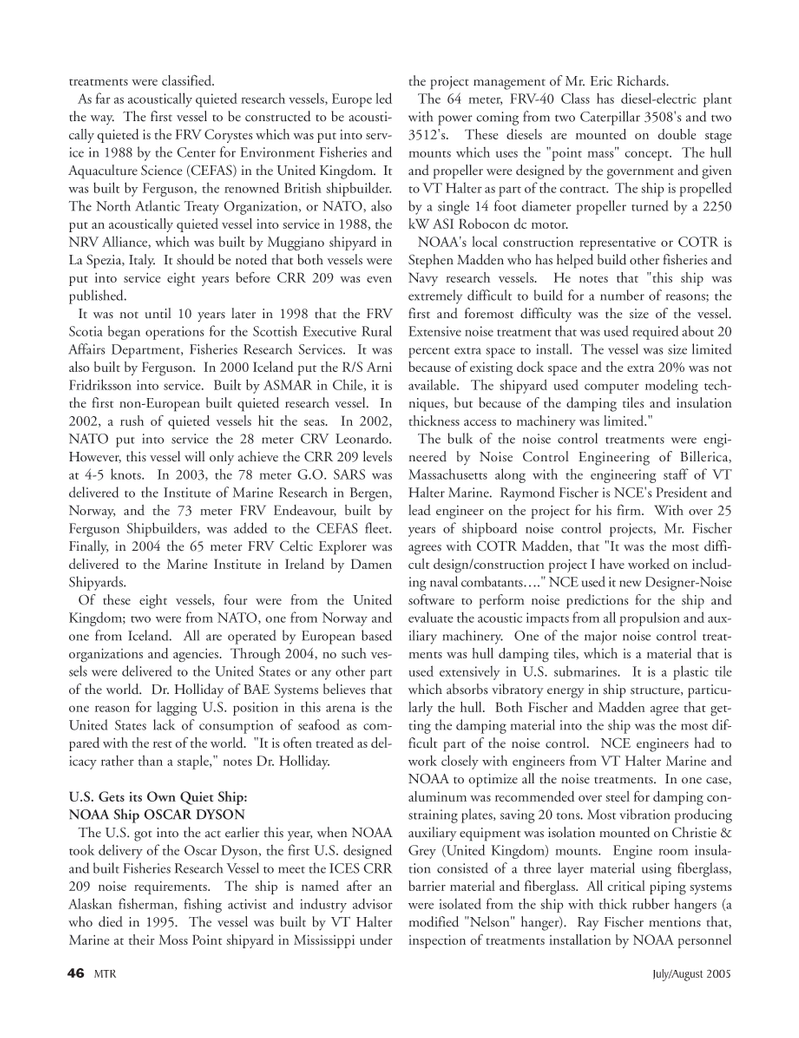
Page 45: of Marine Technology Magazine (July 2005)
Read this page in Pdf, Flash or Html5 edition of July 2005 Marine Technology Magazine
46 MTR July/August 2005 treatments were classified.
As far as acoustically quieted research vessels, Europe led the way. The first vessel to be constructed to be acousti- cally quieted is the FRV Corystes which was put into serv- ice in 1988 by the Center for Environment Fisheries and
Aquaculture Science (CEFAS) in the United Kingdom. It was built by Ferguson, the renowned British shipbuilder.
The North Atlantic Treaty Organization, or NATO, also put an acoustically quieted vessel into service in 1988, the
NRV Alliance, which was built by Muggiano shipyard in
La Spezia, Italy. It should be noted that both vessels were put into service eight years before CRR 209 was even published.
It was not until 10 years later in 1998 that the FRV
Scotia began operations for the Scottish Executive Rural
Affairs Department, Fisheries Research Services. It was also built by Ferguson. In 2000 Iceland put the R/S Arni
Fridriksson into service. Built by ASMAR in Chile, it is the first non-European built quieted research vessel. In 2002, a rush of quieted vessels hit the seas. In 2002,
NATO put into service the 28 meter CRV Leonardo.
However, this vessel will only achieve the CRR 209 levels at 4-5 knots. In 2003, the 78 meter G.O. SARS was delivered to the Institute of Marine Research in Bergen,
Norway, and the 73 meter FRV Endeavour, built by
Ferguson Shipbuilders, was added to the CEFAS fleet.
Finally, in 2004 the 65 meter FRV Celtic Explorer was delivered to the Marine Institute in Ireland by Damen
Shipyards.
Of these eight vessels, four were from the United
Kingdom; two were from NATO, one from Norway and one from Iceland. All are operated by European based organizations and agencies. Through 2004, no such ves- sels were delivered to the United States or any other part of the world. Dr. Holliday of BAE Systems believes that one reason for lagging U.S. position in this arena is the
United States lack of consumption of seafood as com- pared with the rest of the world. "It is often treated as del- icacy rather than a staple," notes Dr. Holliday.
U.S. Gets its Own Quiet Ship:
NOAA Ship OSCAR DYSON
The U.S. got into the act earlier this year, when NOAA took delivery of the Oscar Dyson, the first U.S. designed and built Fisheries Research Vessel to meet the ICES CRR 209 noise requirements. The ship is named after an
Alaskan fisherman, fishing activist and industry advisor who died in 1995. The vessel was built by VT Halter
Marine at their Moss Point shipyard in Mississippi under the project management of Mr. Eric Richards.
The 64 meter, FRV-40 Class has diesel-electric plant with power coming from two Caterpillar 3508's and two 3512's. These diesels are mounted on double stage mounts which uses the "point mass" concept. The hull and propeller were designed by the government and given to VT Halter as part of the contract. The ship is propelled by a single 14 foot diameter propeller turned by a 2250 kW ASI Robocon dc motor.
NOAA's local construction representative or COTR is
Stephen Madden who has helped build other fisheries and
Navy research vessels. He notes that "this ship was extremely difficult to build for a number of reasons; the first and foremost difficulty was the size of the vessel.
Extensive noise treatment that was used required about 20 percent extra space to install. The vessel was size limited because of existing dock space and the extra 20% was not available. The shipyard used computer modeling tech- niques, but because of the damping tiles and insulation thickness access to machinery was limited."
The bulk of the noise control treatments were engi- neered by Noise Control Engineering of Billerica,
Massachusetts along with the engineering staff of VT
Halter Marine. Raymond Fischer is NCE's President and lead engineer on the project for his firm. With over 25 years of shipboard noise control projects, Mr. Fischer agrees with COTR Madden, that "It was the most diffi- cult design/construction project I have worked on includ- ing naval combatants…." NCE used it new Designer-Noise software to perform noise predictions for the ship and evaluate the acoustic impacts from all propulsion and aux- iliary machinery. One of the major noise control treat- ments was hull damping tiles, which is a material that is used extensively in U.S. submarines. It is a plastic tile which absorbs vibratory energy in ship structure, particu- larly the hull. Both Fischer and Madden agree that get- ting the damping material into the ship was the most dif- ficult part of the noise control. NCE engineers had to work closely with engineers from VT Halter Marine and
NOAA to optimize all the noise treatments. In one case, aluminum was recommended over steel for damping con- straining plates, saving 20 tons. Most vibration producing auxiliary equipment was isolation mounted on Christie &
Grey (United Kingdom) mounts. Engine room insula- tion consisted of a three layer material using fiberglass, barrier material and fiberglass. All critical piping systems were isolated from the ship with thick rubber hangers (a modified "Nelson" hanger). Ray Fischer mentions that, inspection of treatments installation by NOAA personnel
MTR#1 (33-48).qxd 7/19/2005 10:02 AM Page 46

 44
44

 46
46
